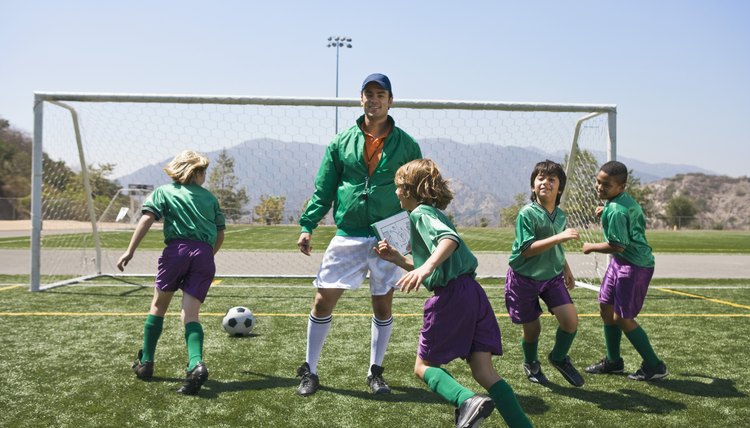Soccer Practice Drills for Fourth-Graders

Practically any activity in youth soccer drill books can be made to work with fourth-graders, whose skills are growing by leaps and bounds compared with players in first or second grades. Fourth-graders, generally called U10s in soccer parlance because they are under age 10, have longer attention spans, an intrinsic motivation to play and a growing awareness of how to work as part of a team, notes U.S. Youth Soccer. Sandwich your practice drills between a warm-up at the beginning and a six-on-six game and cool down at the end of practice.
Beehive
Mark a square measuring 10 yards per side with cones, recommends the Mendon-Upton Youth Soccer Association in Massachusetts, to practice dribbling with the beehive drill. Have each player dribble with a ball, avoiding other players. Add variations, including asking players to vary their speed and dribble at first gear, second gear and so forth, or use their right or left foot only. Or add cones, one per player, asking players to find an unoccupied cone and dribble to it. You also can have one fewer cone than your total number of players. The player who doesn’t get to a cone in time has to do a little extra work, such as a leaper, jumping high in the air and pulling his knees to his chest.
Four Corner Pass
Keep the same grid to work on passing with the four corner drill. Place four players along the midpoint of each side of the grid and one player as a defender in the middle. Players must try to pass to one another across the grid. They are permitted to run between the cones on their side of the grid to make a safe pass. Direct the middle player to change places with the others often to keep the play quick and crisp, the Mendon-Upton Youth Soccer Association recommends.
Possession Game 4v2
Reconfigure your practice area to set up two adjacent squares of 15 by 15 yards for the possession game 4v2. Assign players to two teams of four players each, marked with pinnies or practice vests into red and blue teams. Have all the red players play two of the blue players in one of the grids, while the two additional blue players stand in the other grid. The red players dribble and pass the ball and attempt to keep possession. If a player on the blue team gains possession, she passes the ball into the adjacent square and joins her teammates in that square to attempt to keep possession. The nearest two red players also jump into the new square and play continues.
Shot Stopper
Fourth-graders might be on the cusp of beginning to play with goalkeepers, depending on league rules. An easy drill such as shot stopper, described by the Sterling Soccer Association in Colorado, works to get your fourth-graders interested and succeeding at basic goalkeeping. Stand five to seven yards from the goalie with the ball in your hand. Simulate shots by rolling the ball on the ground, lobbing it in the air or throwing it down so it bounces toward the goal. Calibrate your throws to simulate shots but also to give the keeper a chance to make the save. Have the goalie throw saved balls back to you.
References
Writer Bio
An award-winning writer and editor, Rogue Parrish has worked at the Washington Post, the Baltimore Sun and at newspapers from England to Alaska. This world adventurer and travel book author, who graduates summa cum laude in journalism from the University of Maryland, specializes in travel and food -- as well as sports and fitness. She's also a property manager and writes on DIY projects.
